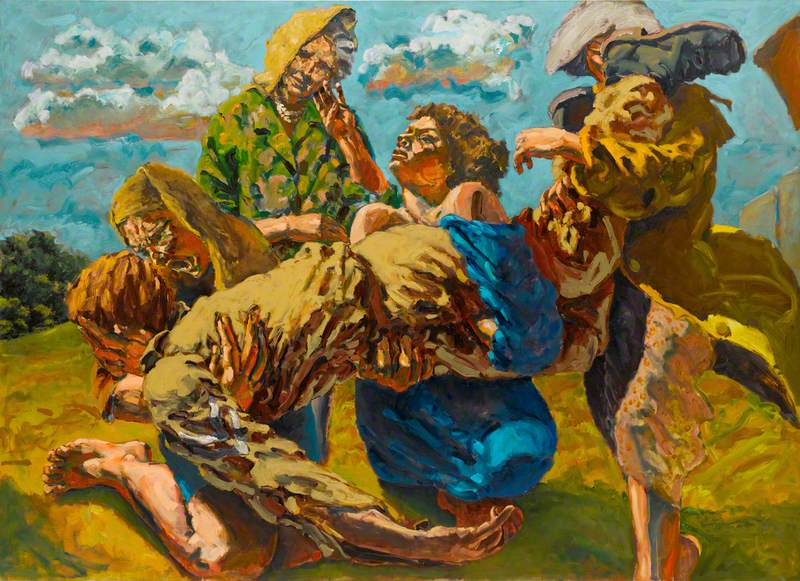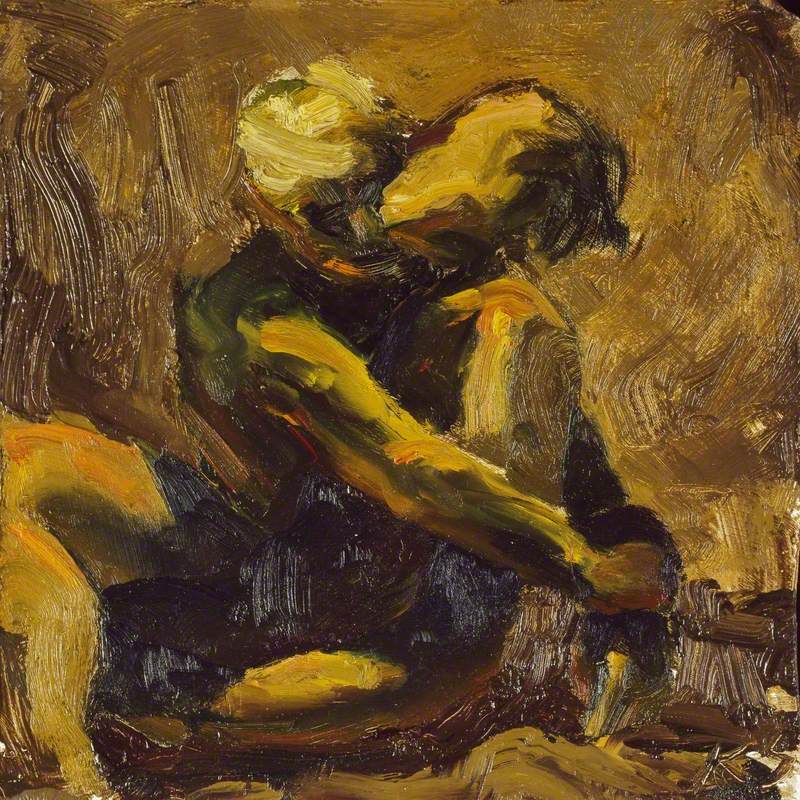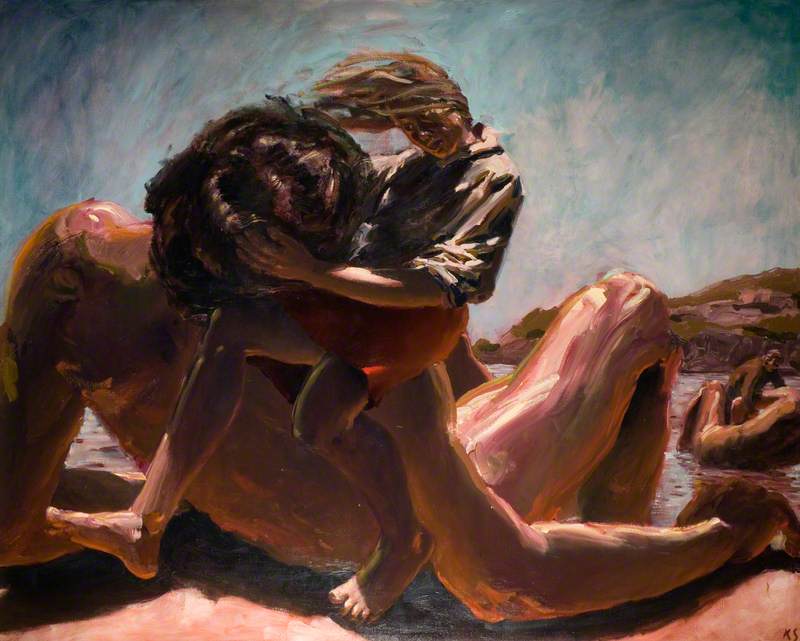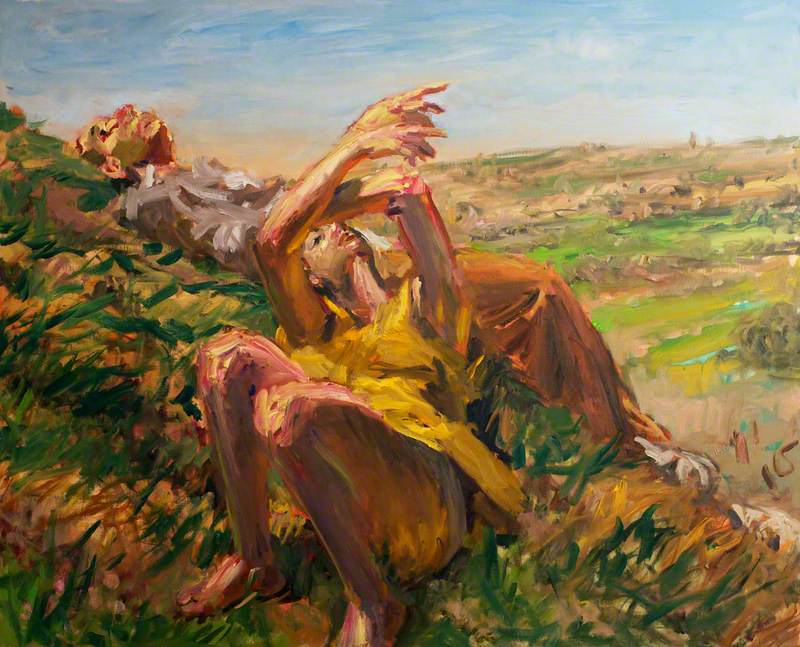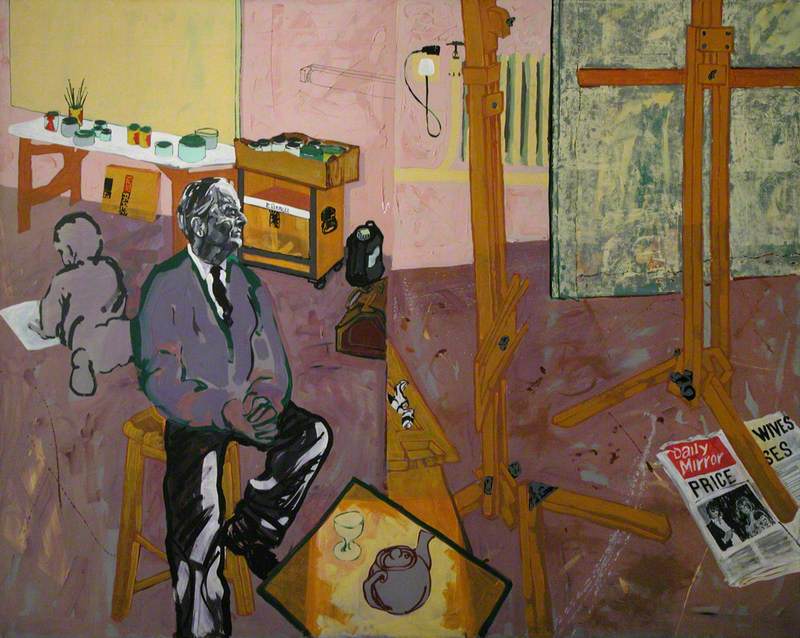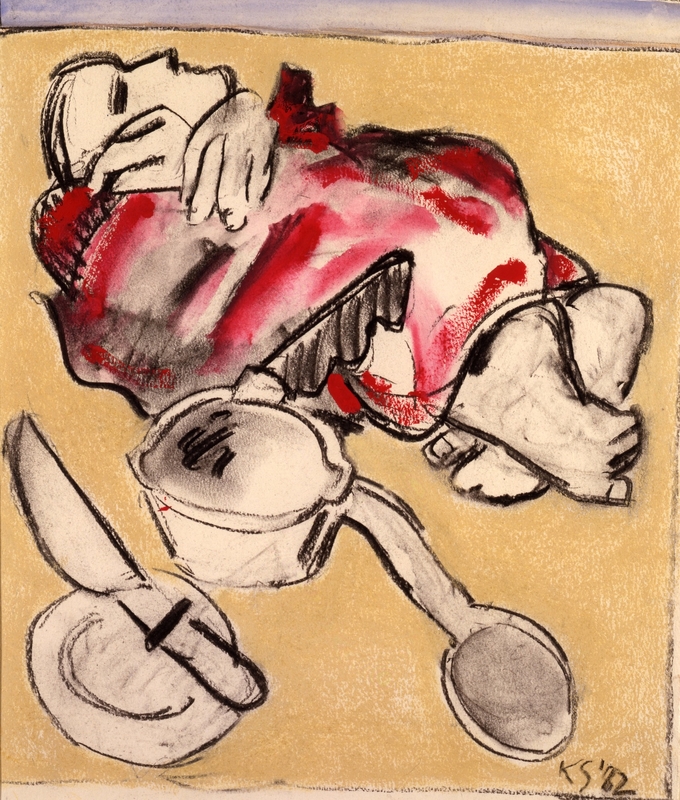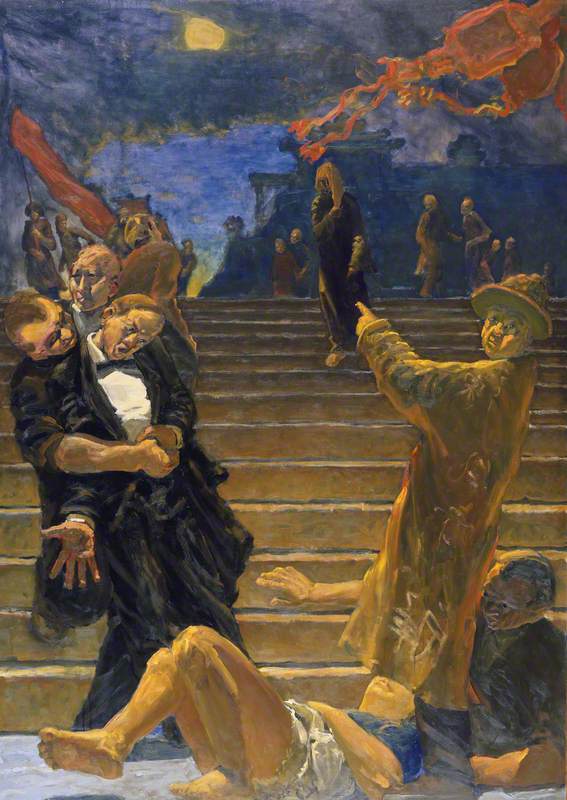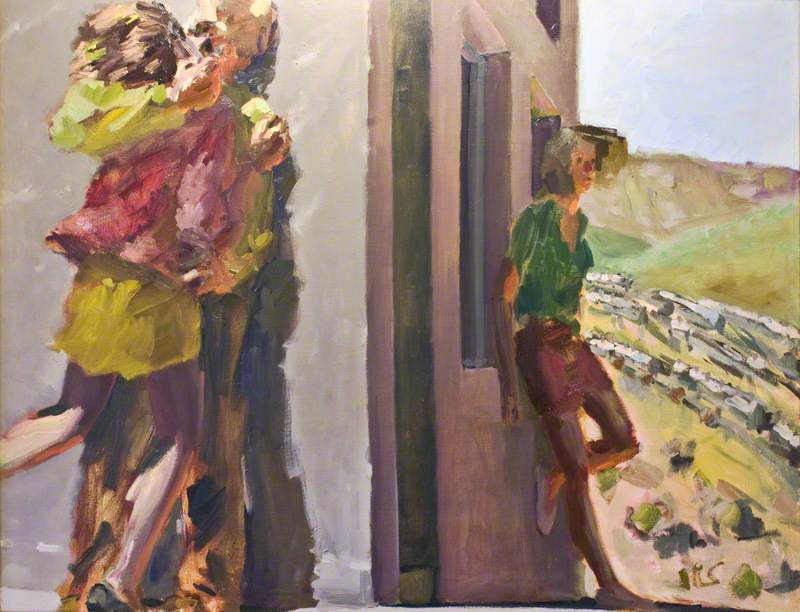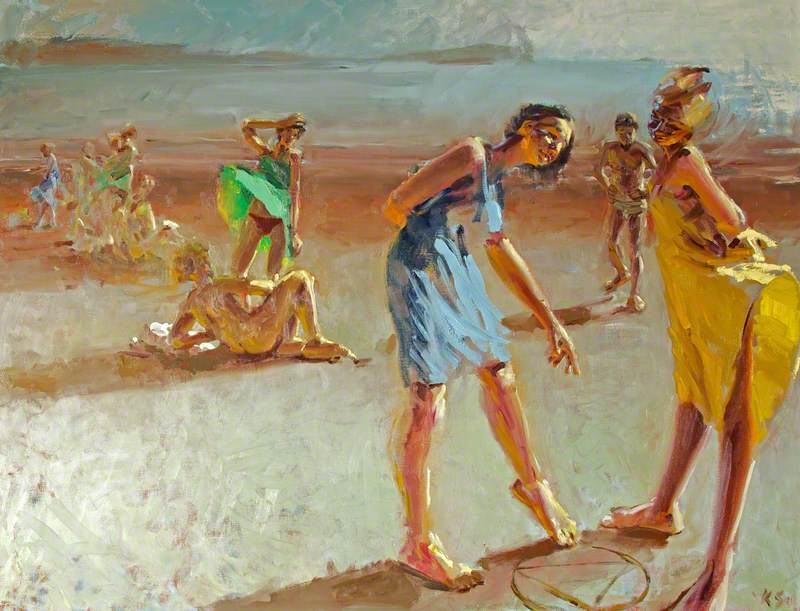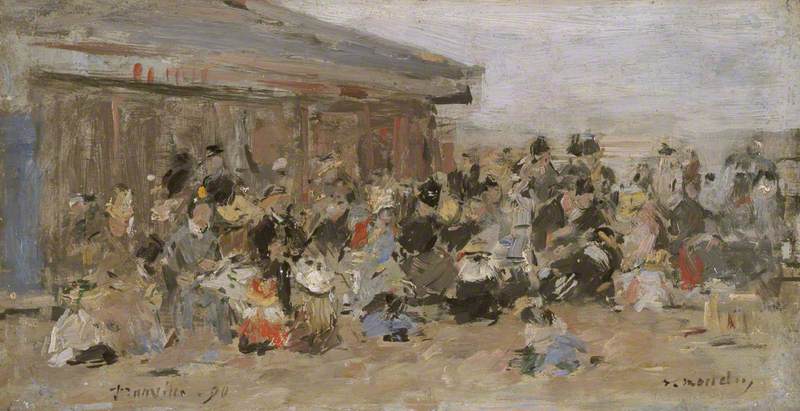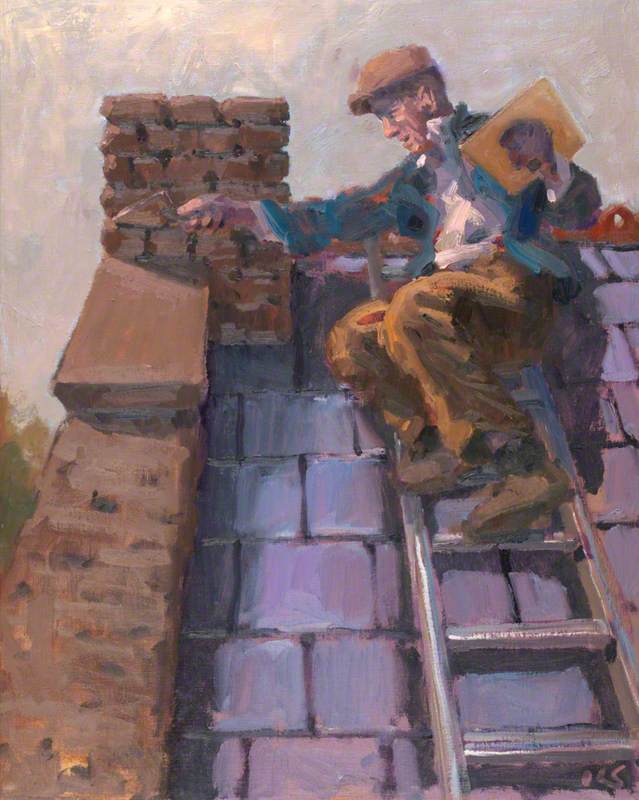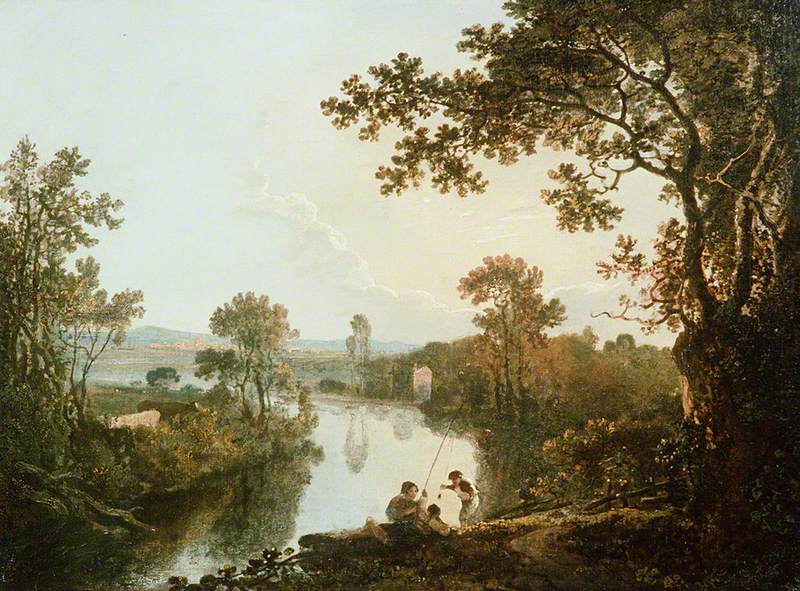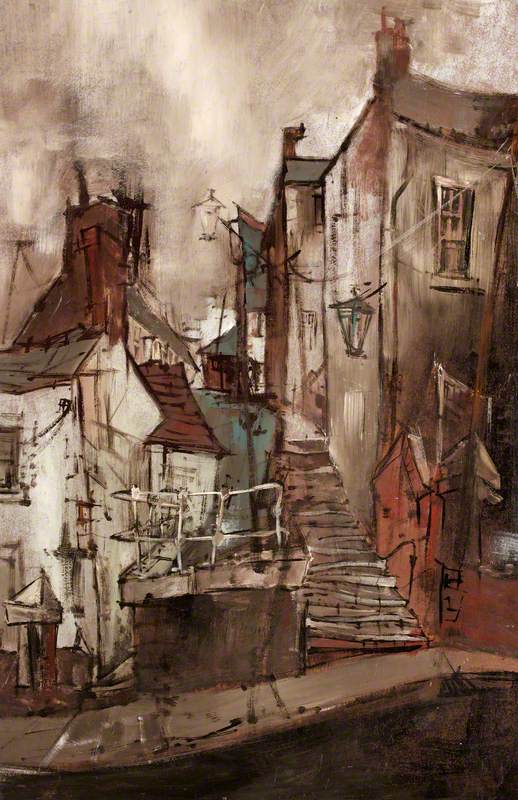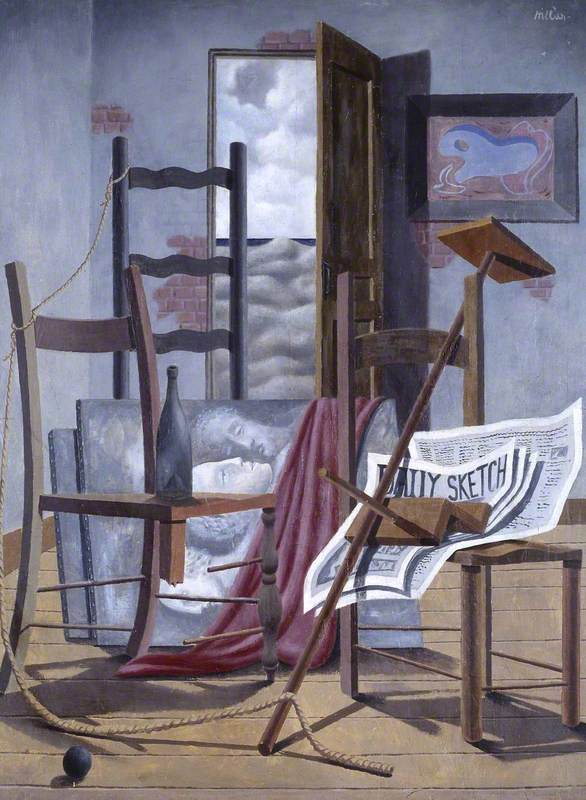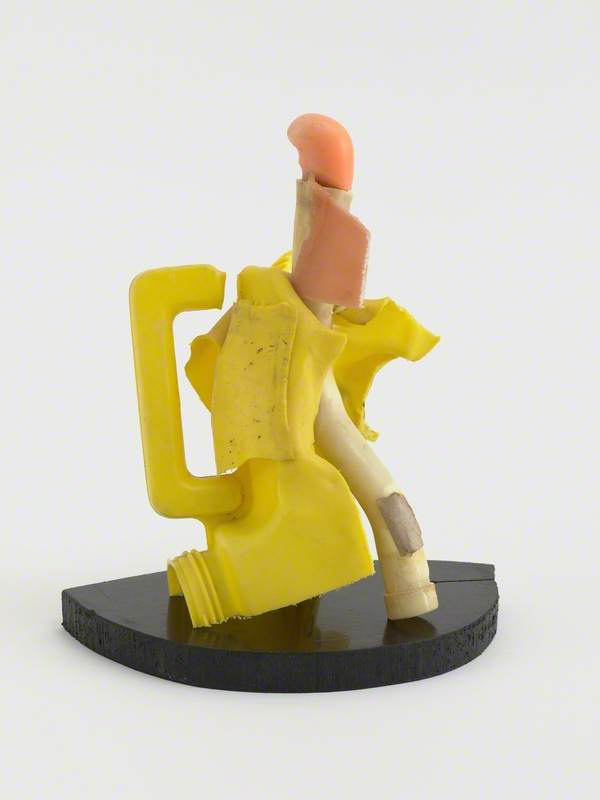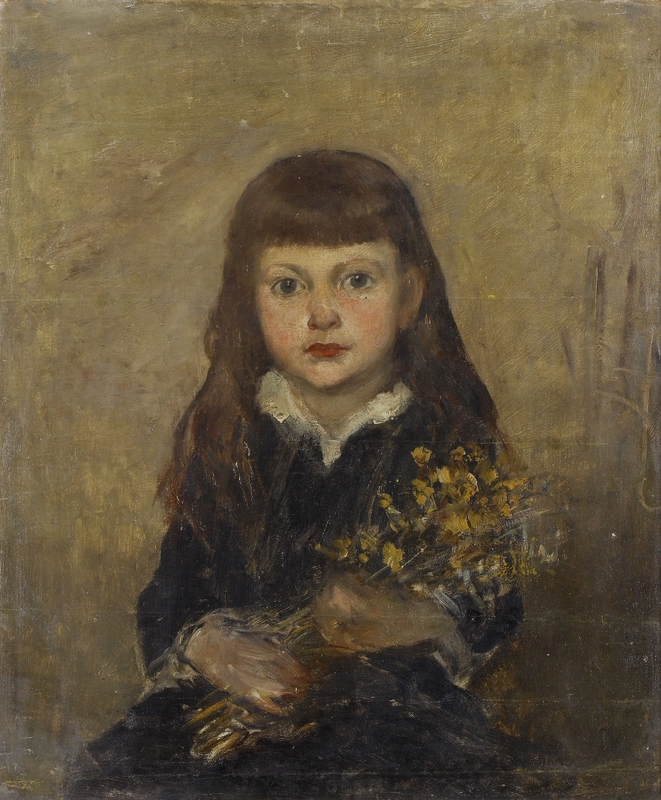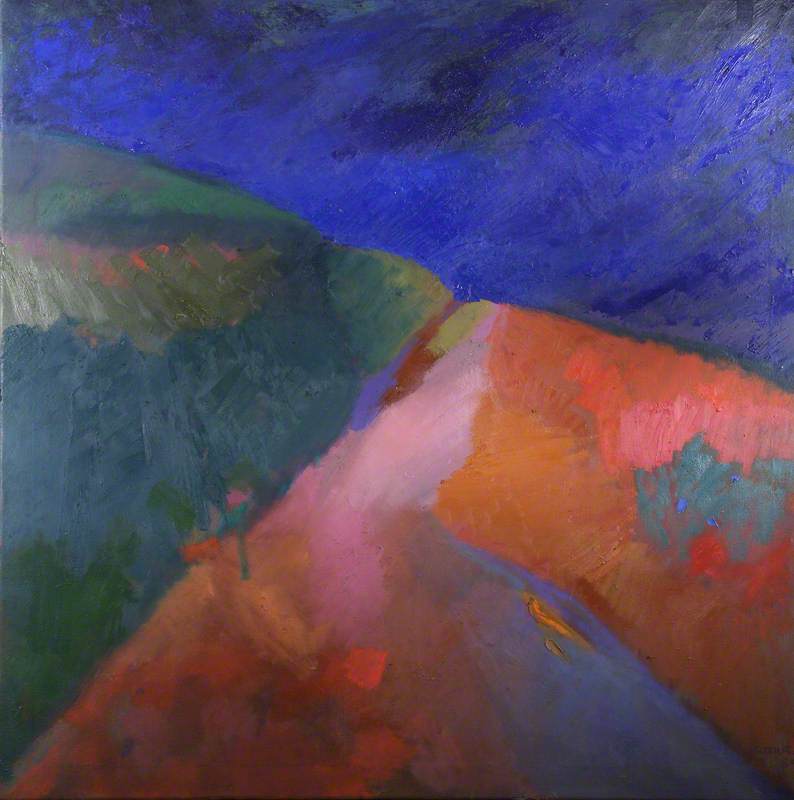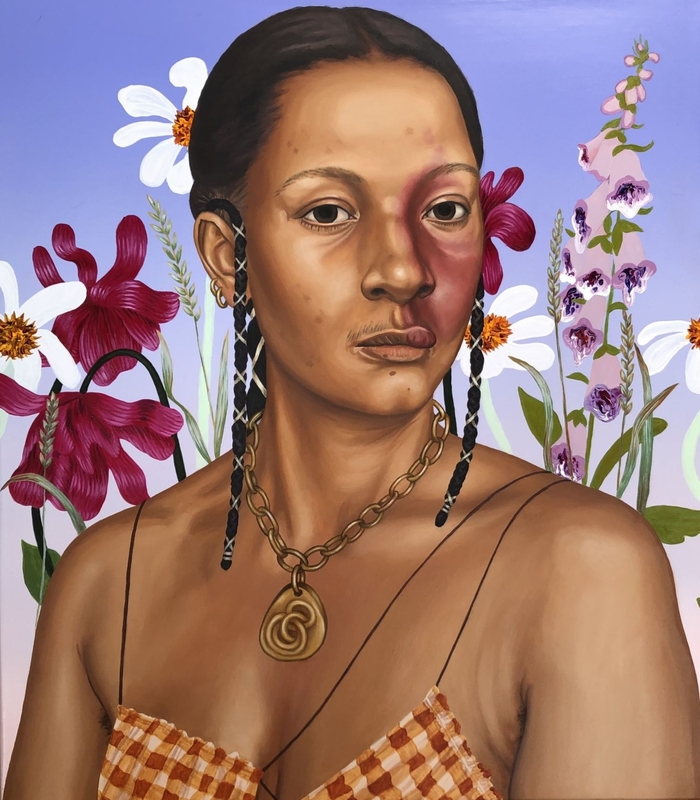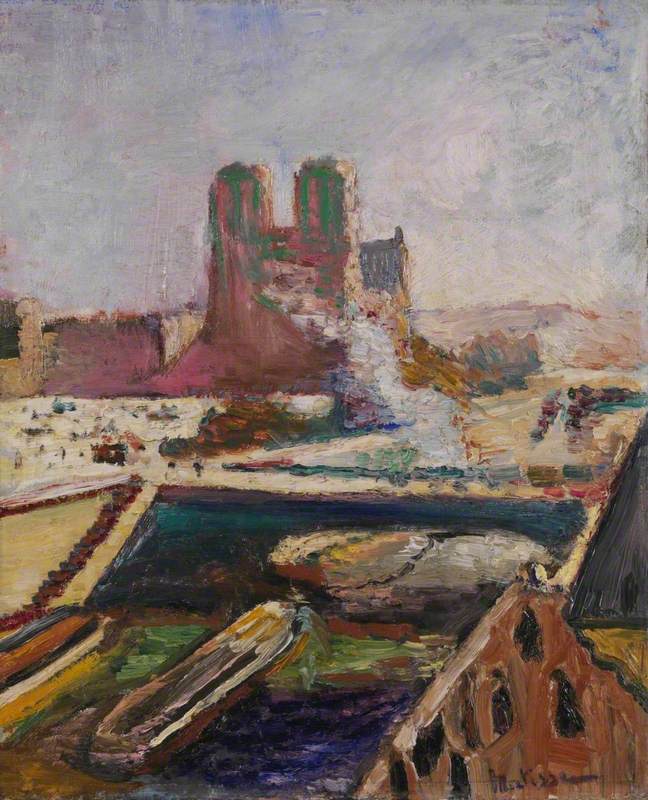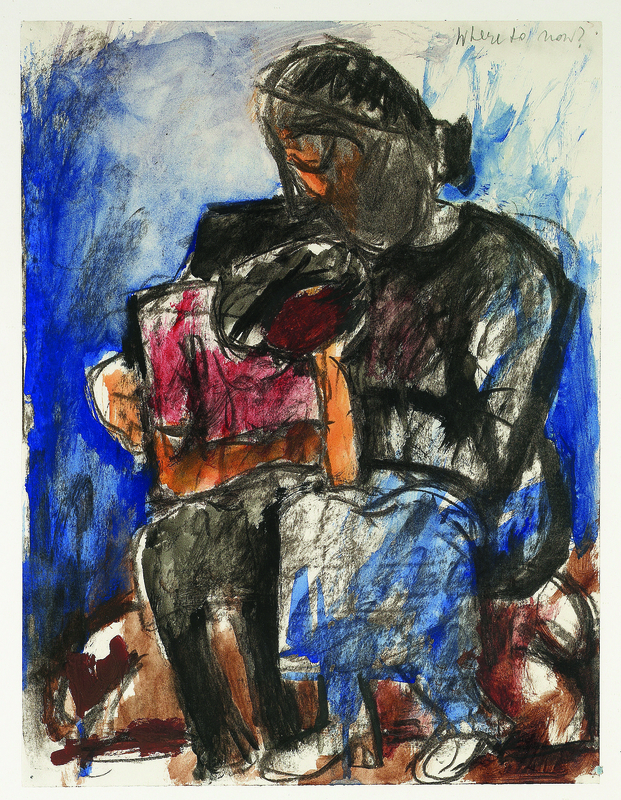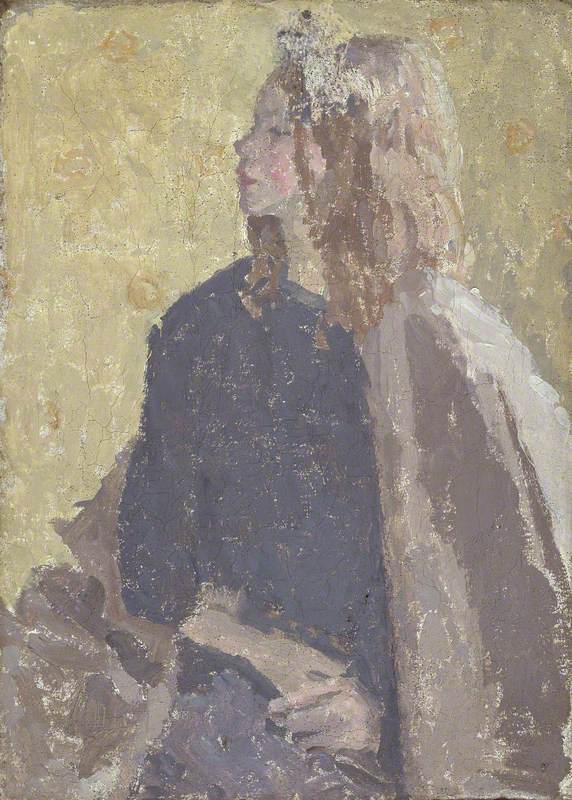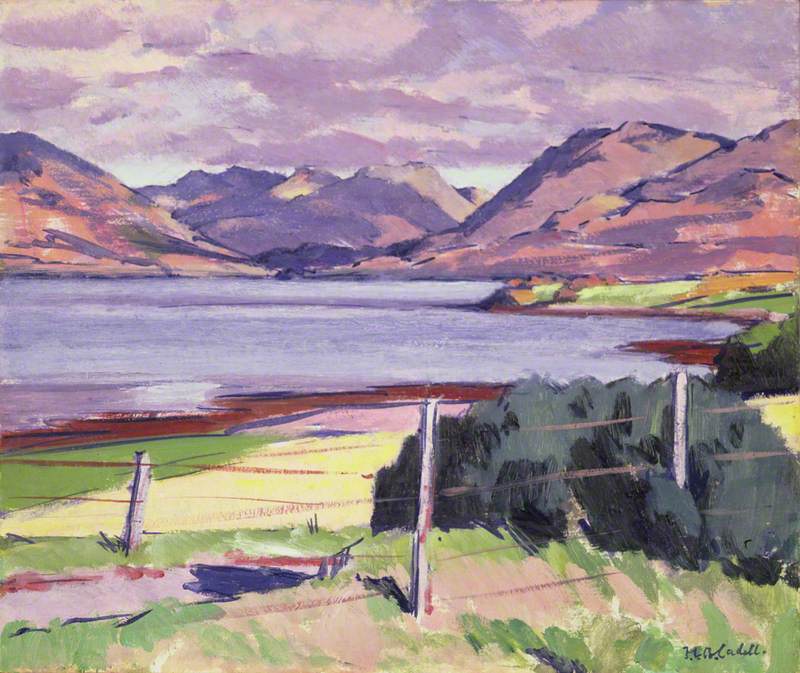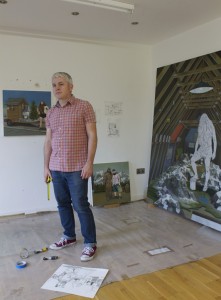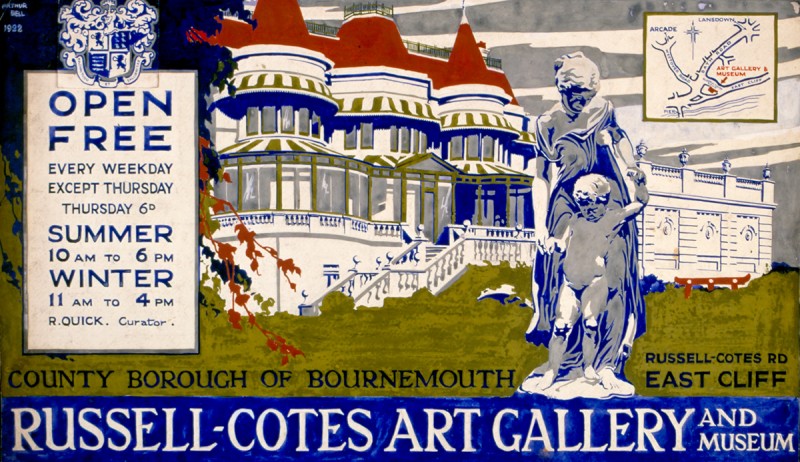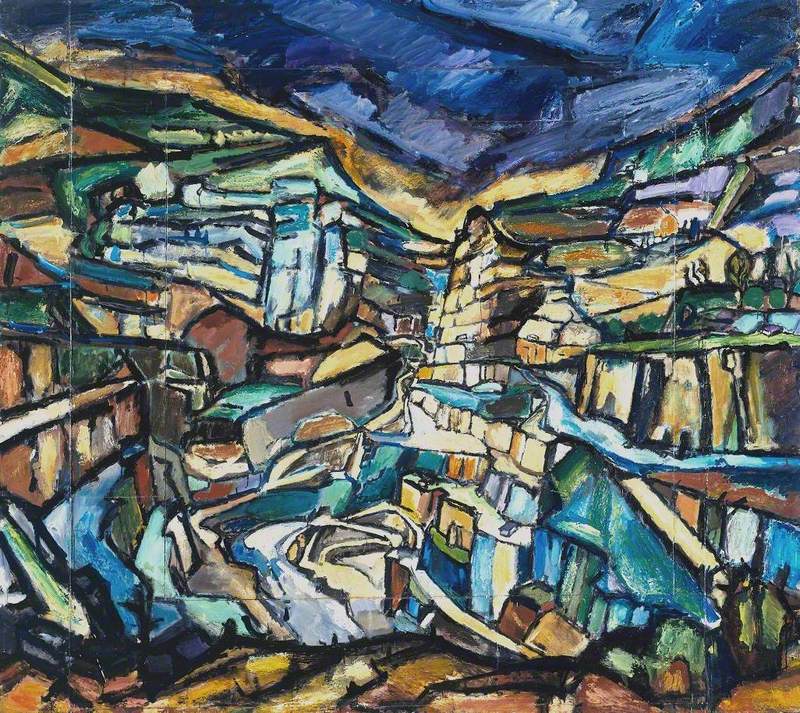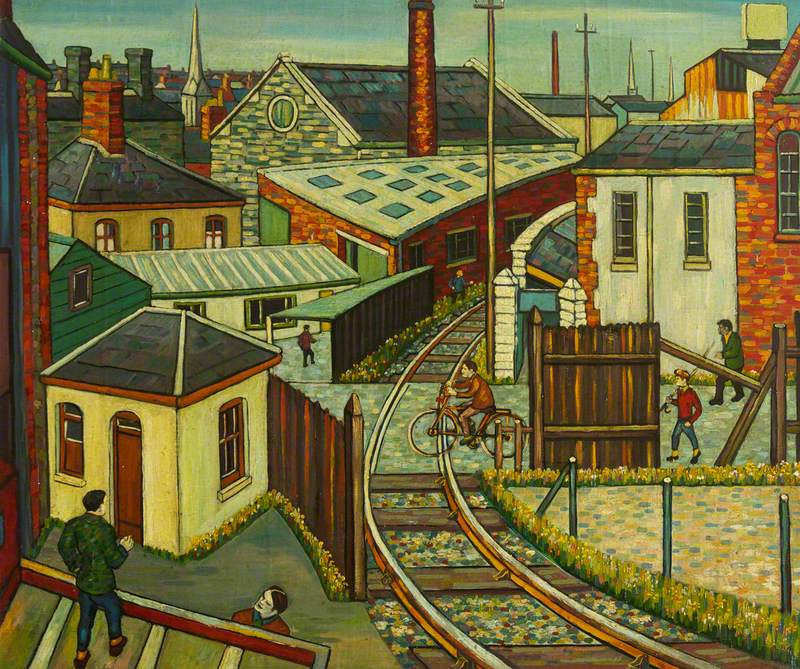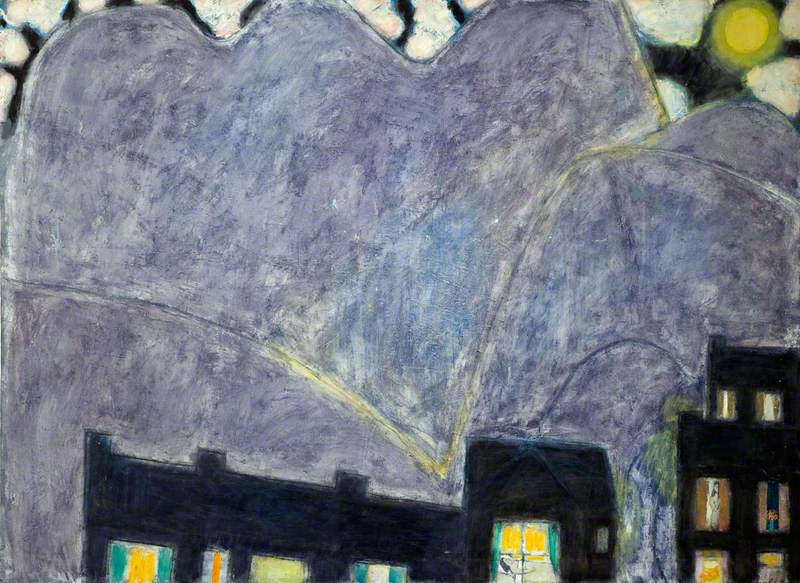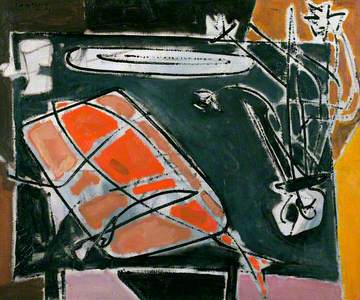Welsh artist Kevin Sinnott is known for his expressive paintings that depict, in his own words, 'the thrill of existence' in moments of everyday life. By painting seemingly ordinary scenes, his work captures a range of human emotions – wonder, joy, melancholy, loneliness and love – brought to life using layers of bold and energetic brush strokes, and a warm colour palette.
This can be seen in Watching the Buzzard. A man and a woman lie on a grassy hillside, pointing up towards a hazy blue sky, under the heat of golden sunshine.
Born in Sarn in 1947, Sinnott left Wales to study at the Royal College of Art in 1971. For some years after this, he worked in a semi-abstract manner. This can be seen in The Studio – a painting of a fragmented room where the pictorial space has been divided into sections, with figures and objects close-up and further away in varying levels of detail. It's also seen in The Universe – a watercolour, pastel and charcoal piece showing an expressively drawn reclining figure wrapped in a red blanket alongside various pieces of kitchenware that distort our sense of scale.
Sinnott notes Patrick Heron as one of his influences for work made between 1975 and 1982 – a period where he was focusing on form over concept. Heron is well known for his abstract and semi-abstract paintings and his use of bright, bold colours. Heron's earlier work was heavily influenced by Georges Braque and Henri Matisse – artists closely associated with Cubism and Abstraction, modernist movements that Sinnott was also interested in. Sinnott's The Universe and Heron's The Red Fish share a visual vocabulary: fluid black lines, the use of white space, and shaded and flat colour.
By the late 1980s, Sinnott was painting mostly using oils on linen, experimenting by scaling up and working with subjects from fiction, imagination and life. During this time he also continued to exhibit internationally and taught at art schools including Ruskin School of Art at Oxford, and St Martin's School of Art in London. Turandot was based on Giacomo Puccini's last opera of the same name. Sinnott said: 'A painting like Turandot had taken me quite a long way down the road from my own more modernist past when content was always secondary.'
Sinnott returned to live and work in Wales in 1993. This allowed him to reconnect with his past, bringing up new emotions and shifting his work to respond even more to his immediate surroundings. He said 'the inspiration which I have gratefully, if not always humbly, received from my immediate environment, has sometimes seemed like a reward for coming home... A reward for the recognition and acknowledgement of my debt to the place in which my peculiar adventure began.'
The south Wales valleys are a notable feature in a lot of his work. Terraced houses and bracken-coloured hills form many of his backgrounds. This can be seen in Wallflower. Rows of terraced homes curve down the hillside, to the right of a young woman who leans against a building, possibly a pub, staring outwards. Around the corner, a young couple embrace and kiss, unaware – or unbothered – by the girl's presence. Perhaps they know each other, perhaps not.
Many of Sinnott's paintings suggest a narrative although it is up to the viewer to choose to piece one together. For the artist, this is of secondary importance. He explains: 'they have a narrative enhanced by the painted image… [but] the success of a painting is first and foremost in its form – decorative space, and the dynamic potential of its composition.'
Geometry Lesson Beach Five shows a playful beach scene: in the foreground, a woman points to a triangle in a circle drawn in the sand, while another woman looks on. It's windy – the green dress of a woman behind them is blown upward, her undergarments revealed as she clings to her hat. Her green dress is echoed by a more abstract figure behind her, while further figures behind recede into the background, a blur of colour and expressive marks. The figures become more and more transparent and increasingly abstract along a diagonal line.
Although this work evokes the sense of recounting a memory where details fragment and blur into one another, the painting primarily plays with pictorial space. It is similar to that of Eugène Louis Boudin's Beach at Trouville, painted a century prior. Both share an expressive rhythm, and marks that blur and spill detail onto each other. Sinnott and Boudin both use a beach scene to explore the materiality of paint on surface without the added weight of a clear narrative.
Working-class life is depicted in many of Sinnott's paintings. In Repointing, we see an older man repointing the chimney of a purple slate roof, dressed in a flat cap and blue worker's jacket. It's a painting that feels matter-of-fact, almost documentary. We witness the labour of the worker alongside shadows cast by a moment of sunshine between clouds. Rhythms emerge from the repetition of rectangular slate tiles, brown bricks and shiny rungs. Oblique angles are emphasised by the way the man bends his knees towards the point of his triangular trowel and the corner of the roof.
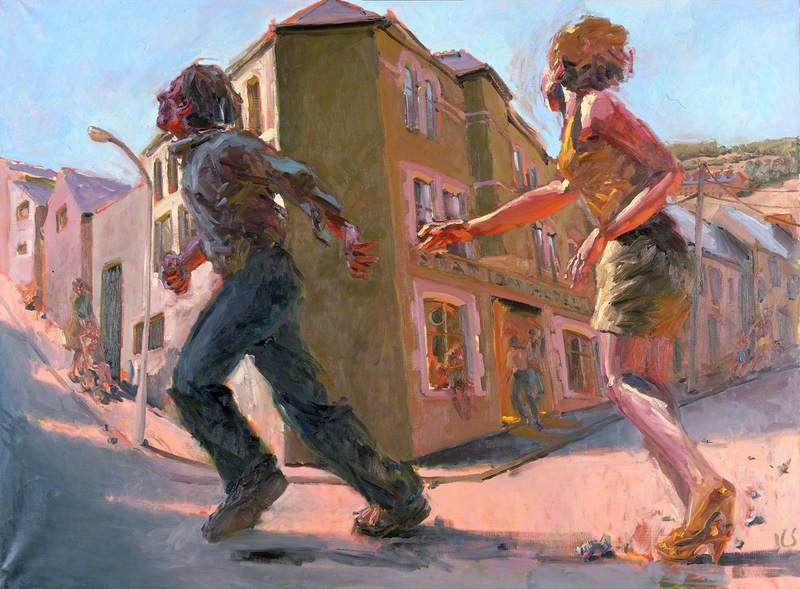
© the artist. Image credit: Amgueddfa Cymru – National Museum Wales
Running Away with the Hairdresser 1995
Kevin Sinnott (b.1947)
Amgueddfa Cymru – National Museum WalesRunning Away with the Hairdresser, Sinnott's most iconic painting, is currently housed at National Museum Cardiff. It's in an almost lifelike scale, and depicts a scene unfolding on a terrace-lined street. A man runs across the road, with a woman running closely behind. Their hands are outstretched, as though they are reaching out to join hands, or as though they had been holding hands but have had to let go. The scene is lit by the orange hue of evening summer sun, as a woman with a pushchair, people at the Station Arms pub, and a woman holding hands with a child all go about their business in the background. The painting originated from a darker painting of a single male figure with the theme of leaving a past behind.
On a visit to National Museum Cardiff, Sinnott himself witnessed a couple laughing in front of his painting. 'They found my painting, when compared to other modern / contemporary art in that room, to be funny and joyful' he said, 'I found their responses a little mysterious.'
Running away implies there is something to escape. Re-encountering Running Away with the Hairdresser at National Museum Cardiff in February 2024, I find myself wondering what or who the figures are running away from. I can't help reflecting on a possible narrative or reaction to the work. I find myself thinking about people the world over currently running away – fleeing abuse, persecution, genocide and war: running away for survival. Running away promises an alternative. Although they are in limbo, the figures are also in motion – hope.
Gweni Llwyd, artist
A Kevin Sinnott Solo Exhibition will be at Ffin y Parc Gallery, Llandudno, from 26th April until 18th May 2024
This content was supported by Welsh Government funding
Artist quotes are from Kevin Sinnott's website, Art UK, and email correspondence between the artist and the author, February 2024
Further reading and watching
Kevin Sinnott, Behind the Canvas, Seren Books, 2008
Kevin Sinnott interview at Canfas, 2024
Gary Raymond, 'Kevin Sinnott in Conversation', Wales Arts Review, 2022
